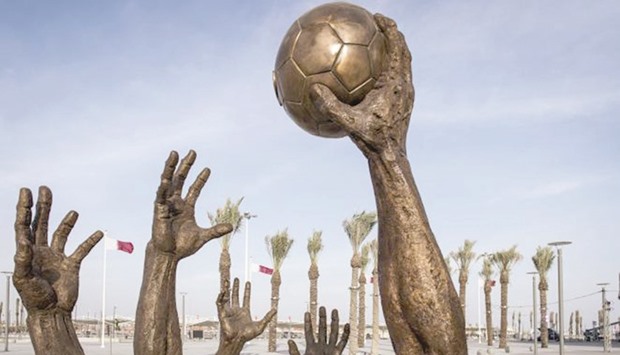Iraqi artist Ahmed al-Bahrani, creator of the large bronze sculptures depicting larger-than-life hands reaching for the sky for the Handball World Cup in Qatar, is once again coming up with an exhibition in town.
The impressive World Cup piece sits just outside the Multipurpose Hall and stops sporting fans and players in their tracks as they wander around the venue.
This time, however, it is his signature take on the horrors of war and conflict that will be depicted through the exhibition ‘What if,’ opening at Katara Art Centre (KAC) on March 20.
Al-Bahrani is internationally renowned for having created thought-provoking large-scale sculptures in the past, such as a gun-toting Mother Theresa, and often bases the themes of his works on past experiences, such as war and exile.
The theme of his upcoming exhibition at KAC revolves around the idea that the connection between people’s humanity has become somewhat detracted and detached from the increasingly atrocious acts that comes from the conflicts of war.
People, both as individuals and collectively as a society, have the untapped and limitless potential to impact and make drastic changes needed to heal the world; however presently this potential is overlooked and instead we tend to fight amongst ourselves and go against each other.
We are at war with each other, and the blood of the innocent is spilled for the gain of only a few.
Al-Bahrani’s reflection on war comes as no surprise — growing up as an Iraqi from Babylon, he has sought for the answer that could end war.
He is one of the many Iraqis who left their country for a new beginning and today he demonstrates his stands on war, through art that challenges the audience.
Al-Bahrani uses bronze and metal to create the unique sculptures that carry out the outspoken statements, which can be seen from his previous exhibition ‘War to War’ in Miami.
In fact, through the ‘What If’ collection of 2015, he illuminates the artwork as a sense of memory, present reminders and future endeavours. One of the collection’s main sculptures is a piece that speaks on behalf of the suffering regions of the world.
It is displayed through 100 donkeys facing one direction and a tank faced in the opposite direction, both made out of fibre glass and painted with white colour. By placing them in different directions, the artist is questioning the human norms and the influence through authority. He seeks for an urgent action, for the world to unite against conflicts.
Born in 1965 in Babylon, Iraq, al-Bahrani obtained a diploma in art from Fine Arts Institute, Baghdad in 1988 and currently lives between Doha, Qatar and Stockholm, Sweden.
Al-Bahrani was inspired to sculpt from childhood, when he created works out of mud in the Euphrates River that were then dissolved and claimed by the river itself. In that way, al-Bahrani proclaims that sculpture chose him, and not the other way round.
His work has departed from the traditional scope of structure that was prevalent in Middle Eastern sculpture, to attain a minimalistic quality that is characterised by both clarity and simplicity. His individualistic approach has resulted in creating a sense of flexibility and movement to an otherwise heavy and rigid material.
Of his inspirations, al-Bahrani says that Babylon and its legends, and its holy books, were his life support during his years away from Iraq. His passion for this ancient civilisation, rooted in the stories of the mythical Ashtar and her love of Tamuz, comes across in his strong, inexorable statues, and his art.
Like many Iraqi artists of his generation in the diaspora, al-Bahrani was affected by the grave damage inflicted on Iraq.
He has attempted to convey the message of a being who has been estranged from his geographical foundation and his roots. It is, for the artist, a journey that only those exiled from their homelands can understand.
The music of al-Bahrani’s injured city, and the pain of its people, continue to haunt the artist who cannot forget his country and its epic chant.
In all of al-Bahrani’s works he seeks to demonstrate that for him, there is no land as beautiful as Babylonia, of greater Mesopotamia, the mother of the Euphrates and Tigris and a wealth of civilisation that it bestowed on the rest of the world.

MASTERPIECE: The hands sculpture at Lusail Multipurpose Hall by Ahmed al-Bahrani.
